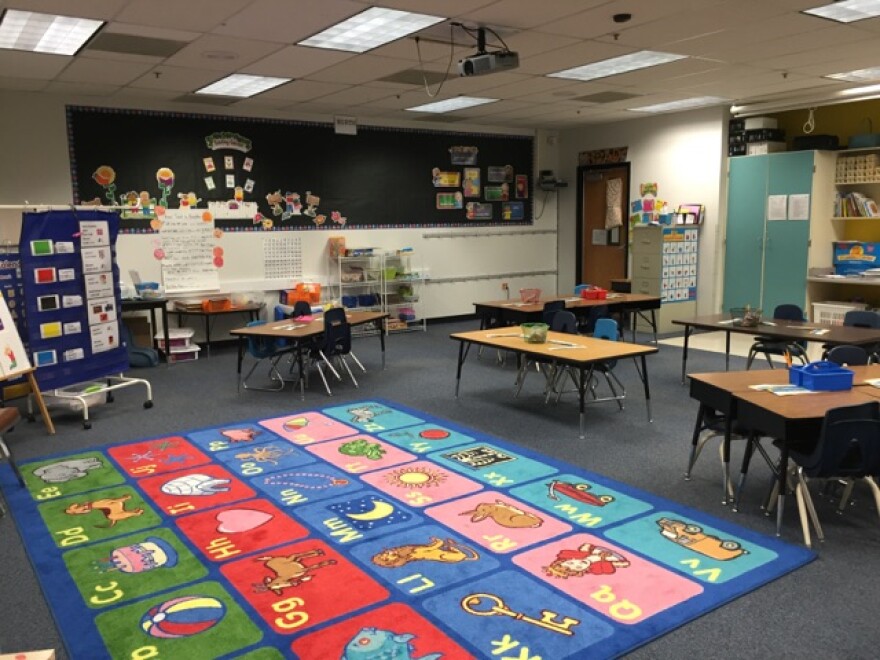Tuesday the Washoe County School Board will decide whether schools that are severely over-capacity must switch to a year-round schedule by next fall. Brown Elementary School in South Reno is the most overcrowded in the district and parents there are eagerly awaiting the board’s decision. Reno Public Radio’s Anh Gray visits the school to learn about its challenges for our series on overcrowding, “Bursting at the Seams.”
Year-round schooling or what’s also referred to as a multi-track plan is one mechanism the Washoe County School District uses to cut-down on the number of kids in school. The student body is divided into four tracks. One track is always off, removing about a quarter of the school’s population from the building.
“In order to do what’s best for kids, you need teachers to collaborate and work together. In order to work and collaborate together, you need to be here at the same time,” Brown’s Principal Angie Bryan says. “When you’re on a multi-track system, there’s always 25 percent of your students gone, but there’s also 25 percent of your teachers and your grade-level gone.”
Bryan has been trying a variety of temporary fixes for overcrowding like multiple lunch periods, team-teaching and portable classrooms—there are 10 extra held at Brown—to be exact. While on a tour with Bryan, she shows me yet another solution: repurposing space by moving classrooms around.
Angie Bryan: “This used to be our computer lab, so I’ll show you real quick. When we go back to year-round, it’ll be our computer lab again.”
Anh Gray: “Okay…So, this is the former computer lab that’s you’ve turned into a classroom…”
Angie Bryan:“Kindergarten classroom now.”
To make room for that kindergarten class, the computer lab has been relocated. We walk down the hallway, where several rows of tables and chairs are neatly arranged. Portable storage cabinets concealing computer equipment are nearby. Bryan explains that this open space is now the school’s computer lab. A brown plastic tarp has been erected as a “wall” on one side.
“It blocks enough that the kids know that it’s their classroom,” Bryan says. “They know that when they’re outside of it they use their “HALLS,” which is hands to the side, all eyes forward, lips zipped, low speed, single file."

As we meander through the halls, Bryan opens the door to a former textbook storage room—roughly 200 square feet—it’s now the shared space for part-time English Language Learners and counseling. Despite dealing with such tight quarters, Bryan is one of those educators who tries to make the most with the little they’ve been given.
“I always focus on the positive. Our vision at this school is learning through perseverance,” Bryan says. “Our teachers focus on what’s best for kids. Structures and procedures are in place so that when parents walk through the building, it doesn’t feel like it’s overcrowded. Is it overcrowded? Yes.”
But parent Paula Wachsman says students do feel the squeeze.
“Yes, they do notice that,” Wachsman says. “They do notice the crowding on the playground and they do notice the crowding in the hallways.”
Wachsman was one of about 40 parents who gathered in Brown’s cafeteria for a recent Parent Teacher Organization meeting to hear about the school’s plan to delay going on multi-track for one more year.
Area Superintendent Chad Hicks told the group the current school infrastructure just can’t keep up with growing demands in the community.

“The projected numbers coming in based on businesses and new developments going up everywhere—it’s staggering—it’s to the point now where if we were to build a new school in the next two to three years, it’s likely that school would start on multi-track,” Hicks says. “That’s how high it is.”
Paula Wachsman stepped up to the mic. “We have a $120 million shortfall per year for school construction for the next nine years. New development needs to be made to pay for itself," Wachsman says. "And that’s not going to change without a change in laws, and law aren’t going to change without us getting on our lawmakers. Thank you.”
Wachsman along with other parents like Doug Clemens are vexed by the upheaval year-round schooling could potentially have on their families.
“I’m greatly opposed to going multi-track. My biggest concerns are mostly what to do with our children during the off-track periods,” Clemens says. “Right now, during summer, winter and spring breaks, there are a lot activities in town that we can have our children go to, and my biggest concern is during the off-track periods, will there be those types of activities for my children to go to?”
That scheduling quagmire Clemens mentioned will be something he and other parents must figure out. Eventually, switching to multi-track can’t be avoided unless new schools are built. At Brown, specifically, the numbers are stacked against them with more than 900 students attending a school built for about 600.








